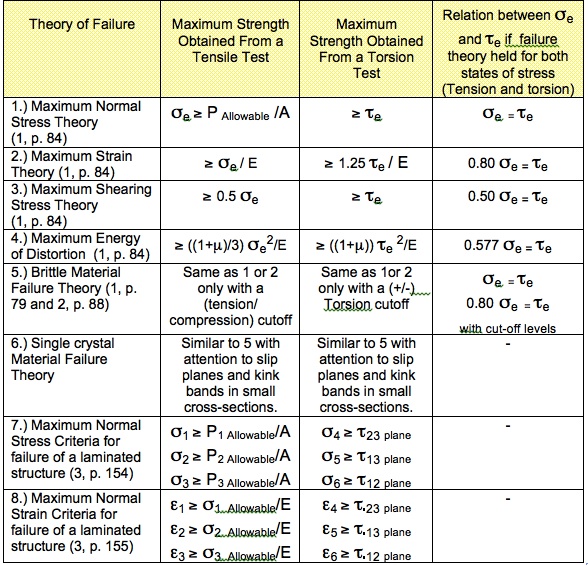Latest News
January 1, 2011
By Fred C. Jensen, P.E., MSME
Engineers are seeing some really wonderful new materials become available to do our work. In our desktop engineering environment, the most exciting developments in materials are coming from lightweight carbon fiber for structural applications, laminated composites and single crystal materials.
These new materials require a serious look at what causes structural failure. The most common material failure theory for ductile materials is the maximum energy of distortion failure theory. This is best known as the Von-Mises failure theory and is the default criteria used in most finite element analysis (FEA) programs.
Below is a summary table of material failure theories that we use a lot in our work. Failure is assumed to occur if any of the listed relationships are satisfied.
| Comparison of Important Failure Theories |
 |
 |
The composite laminate failure criteria, shown in the table as items 7 and 8, were originally developed to predict initial failures of the laminate. It is sometimes more useful to predict actual modes of laminate failure. Reference 3, page 160, and reference 4 present Hashins criteria for fiber failure in both tension and compression, matrix failure, as well as delamination failure. The source documents or the web should be studied for a complete discussion of laminate failure theory.
Fred C. Jensen, P.E., MSME is director of engineering at Patriot Engineering Company, which has been providing mechanical engineering solutions (design, FEA, machine/product development, machining and build) since 1979. You can send comments about this article to [email protected].
References:
- Advanced Mechanics of Materials, by Fred Seely & J. Smith, 2nd edition, John Wiley & Sons, 1952.
- Plasticity for Structural Engineers, by W. F. Chen, and D. J. Han, Springer-Verlag, New York, 1988.
- Practical Analysis of Composite Laminates, by J.N. Reddy and A. Miravete, CRC Press, 1995.
- Failure Criteria for Unidirectional Composites, by Z. Hashin, Journal of Applied Mechanics, 47, page 329-334, 1980.
Subscribe to our FREE magazine, FREE email newsletters or both!
Latest News
About the Author
DE’s editors contribute news and new product announcements to Digital Engineering.
Press releases may be sent to them via [email protected].






